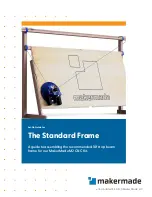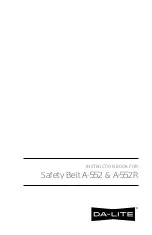
8
ENGLISH
INSTALLATION
1. Preparing the excavation pit
A 10 cm thick bedding layer must be considered for the exca-
vation pit.
The gradient of the sides of the excavation must be less than
45° in the case of granular (non-cohesive) soils, and less than
60° in the case of cohesive soils. Steeper sides must be se-
cured properly and appropriately with sheeting and other
measures.
The 10 cm thick bedding layer must be made of non-cohesive
soil, such as sand, gravel or crushed material with a grain size
of 2 to 20 mm, without pointed or sharp-edged components
and with a degree of compaction of 97% D
Pr
.
The entire surface of the bedding must be levelled.
2. Insertion of the lower part of the pump
sump
All components and especially the sealing surfaces must be
checked for dirt and damage before processing and installa-
tion and cleaned or completely replaced if necessary. The in-
dividual pump sump elements are joined together with sealing
rings.
Use a suitable hoist to relocate the lower part into the excava-
tion pit and align it horizontally and vertically on the bedding
layer.
NOTE!
Vertical alignment must be checked in all directions.
Later corrections result in stresses with a risk of cracking.
Inlet pipe.
Connect the inlet pipe to the pipe socket with a dou-
ble pipe socket.
DN 40 pressure pipe.
The pressure line is connected to the
pressure pipe outlet "1½" with a cable gland (accessory).
DN 80 pressure pipe.
These pump sumps use built-in earth slid-
ers (accessories). The installation fittings and the lengths of the
slide rods are designed for standard lengths. Intermediate sizes
must be adapted on-site. The connection to the pressure pipe is
made with a flange connection.
3. Filling in the excavation pit
ATTENTION!
Top soil, clay, other cohesive soils and the exca-
vated soil are not generally suitable for filling in the excavated
hole.
Please use non-cohesive soil such as sand, gravel or crushed
material with a grain size of 2 to 20 mm, without sharp and
sharp-edged constituents, as filling material.
Fill in layers of 30 cm at a time and compact the soil to 97% D
Pr
.
NOTE!
The pump sump and the individual elements must not
be loaded on one side during filling and compaction.
If a groundwater lowering system is used to create the excava-
tion pit, the filling material can be compacted by adding water
at the same time. However, no cohesive components may be
present. The system is only switched off after the excavation
pit has been compacted.
4. Mounting a sump extension PSV-D
(accessory)
The PKS-D 1000-D65 and -D80 are supplied with an extension
element with tie-bar.
NOTE!
If several extensions are used, the extension with tie-
bar must always be located directly below the cone.
Insert the enclosed sealing ring DN 1000 with the sealing lips
pointing downwards into the top groove of the underpart of the
pump sump. Then coat the sealing ring and sleeve of the pump
chamber element evenly with lubricant (accessory).
Now the sump element can be placed on the lower part, aligned
on the outside using the longitudinal rib and then pushed to-
gether until it stops.
NOTE!
Do not tilt the sump element when doing so.
Now the excavation pit is further filled and compacted and, if
necessary, further elements are added in the same way.
5. Connection of vent and cable pipe
Insert the seal from the outside
without
lubricant into the
opening Ø 136 mm and push it in as far as it will go. Then coat
the pipe with lubricant and push it in to the desired depth.







































